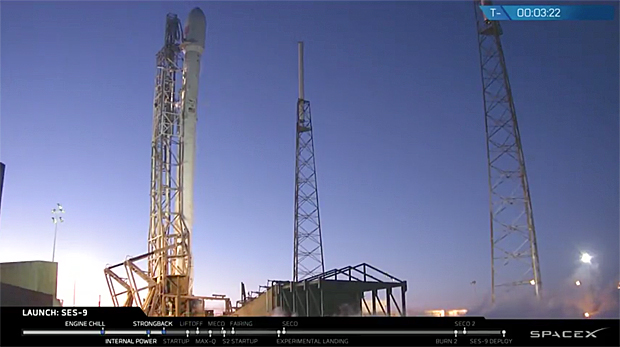SpaceX launch aborted due to last-minute fueling snag
A second attempt to launch a SpaceX Falcon 9 rocket carrying a powerful communications satellite was called off at the last minute Thursday evening because of apparent problems loading the booster with super-cooled liquid oxygen.
Already running a day late because of a temperature-related propellant issue, the countdown was ticking smoothly toward liftoff at 6:47 p.m. EST (GMT-5) Thursday when an engineer on the countdown net suddenly called out "hold, hold, hold" at the T-minus one-minute 41-second mark.
Even though the launch window extended to around 8:23 p.m., SpaceX officials aborted the countdown and, after some initial confusion, said they were done for the day. As usual, SpaceX did not provide much in the way of detail other than to tweet "teams are reviewing the data and next available launch date."
This is only the second flight of an upgraded Falcon 9 rocket featuring a variety of improvements to increase launch performance. The systems were successfully flight tested during a successful launch in December.
The upgraded booster is five feet taller than the previous version -- 229 feet -- and features an extended "interstage" section separating the first and second stages, along with an improved stage separation system. The second stage propellant tanks were extended and its single Merlin 1D engine features a longer nozzle and can generate 210,000 pounds of thrust in vacuum.
That engine, plus nine in the rocket's first stage, burn refined kerosene fuel, known as RP-1, and liquid oxygen. Liquid oxygen has a temperature of around minus 298 degrees Fahrenheit but the "LOX" used in the upgraded rocket is cooled to minus 340 degrees. The RP-1, which normally is stored at a room temperature 70 degrees, is chilled to 20 degrees.
"One of the things we're doing for the first time, the first time I think anyone's done it, is deeply cryogenic propellant," SpaceX founder Elon Musk said before the December flight. "We're sub-cooling the propellant, particularly the liquid oxygen, close to its freezing point, which increases the density quite significantly.
"The thrust is higher, we've improved the stage separation system, we stretched the upper stage of the rocket to add more propellant to that. There are a number of other improvements in electronics. It's a significantly improved rocket from the last one."
Wednesday's launch try was called off before fueling even began due to concerns the liquid oxygen stored at the launch site was not quite cold enough. This evening's scrub was ordered as fueling was nearly complete.
"We were just wrapping up liquid oxygen loading on first and second stage," said SpaceX product manager John Insprucker. "Right now, preliminary, is that we were still evaluating the liquid oxygen propellant load, looking at how much time we had left in the count to finish loading the liquid oxygen. And at that time, the launch team decided we would need to halt the countdown."

